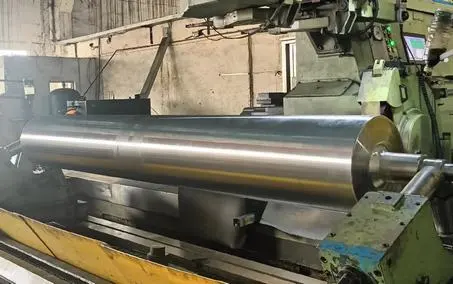The Importance of Stabilizer Rolls in Industrial Processes
Role in Maintaining Web Tension
Stabilizer rolls are indispensable components in many industrial processes, particularly in applications involving continuous web handling. These rolls are engineered to maintain consistent tension across the width of materials such as paper, film, or metal sheets as they move through production lines. By evenly distributing pressure and compensating for minor variations in material thickness or surface irregularities, stabilizer rolls ensure that the web remains taut and properly aligned throughout the process. This precise tension control is critical for preventing wrinkles, creases, or other deformations that could compromise product quality or lead to machine jams and subsequent downtime.
Vibration Dampening Properties
Another key function of stabilizer rolls is their ability to dampen vibrations in high-speed production environments. The specialized design and materials used in these rolls help absorb and dissipate mechanical oscillations that can arise from various sources, including machine operation, material inconsistencies, or external factors. By minimizing vibrations, stabilizer rolls contribute to smoother operation of production equipment, reduced wear on machine components, and improved overall product quality. This vibration dampening effect is particularly valuable in precision manufacturing processes where even minor fluctuations can lead to defects or misalignments that necessitate production stoppages for adjustments or repairs.
Enhancement of Product Quality
The implementation of high-quality stabilizer rolls directly translates to enhanced product quality across various industries. In paper production, for instance, these rolls help maintain uniform caliper and surface finish, resulting in consistent printability and reduced waste. In metal processing, stabilizer rolls contribute to achieving tighter tolerances and improved surface characteristics of rolled products. By ensuring that materials move through production lines with minimal distortion or stress, these rolls play a crucial role in meeting stringent quality standards and reducing the incidence of defects that could lead to production interruptions or customer rejections. The ability to consistently produce high-quality output not only minimizes downtime associated with quality control issues but also enhances a manufacturer's reputation and competitiveness in the market.
Design Features That Contribute to Downtime Reduction
Advanced Materials and Coatings
The effectiveness of stabilizer rolls in reducing production downtime is greatly enhanced by the use of advanced materials and coatings. Modern rolls often feature cores made from high-strength alloys or composite materials that offer superior rigidity and dimensional stability even under high loads and temperatures. The surface of these rolls is typically treated with specialized coatings such as chrome plating, ceramic, or polymer compounds. These coatings serve multiple purposes, including improving wear resistance, reducing friction, and preventing material buildup on the roll surface. By extending the operational life of the rolls and minimizing the need for frequent cleaning or maintenance, these advanced materials and coatings significantly contribute to reduced downtime and increased production efficiency.
Precision Balancing and Alignment
Another critical design feature of high-quality stabilizer rolls is their precision balancing and alignment capabilities. Manufacturers employ sophisticated techniques to ensure that rolls are perfectly balanced both statically and dynamically. This meticulous balancing process minimizes vibrations and ensures smooth operation even at high speeds. Additionally, advanced alignment systems are often integrated into the roll design or the surrounding machinery to maintain optimal positioning throughout the production process. Some stabilizer rolls incorporate self-aligning bearings or adjustable mounting systems that can compensate for minor misalignments or deflections in real-time. These features collectively contribute to extended equipment life, reduced wear on associated components, and minimized downtime due to alignment-related issues or bearing failures.
Intelligent Monitoring Systems
Modern stabilizer rolls are increasingly equipped with intelligent monitoring systems that play a crucial role in preventing unexpected downtime. These systems typically include sensors that continuously monitor various parameters such as temperature, vibration levels, and surface condition of the rolls. By providing real-time data on roll performance and potential issues, these monitoring systems enable predictive maintenance strategies. Operators can identify and address potential problems before they escalate into failures that would necessitate production stoppages. Some advanced systems even incorporate machine learning algorithms that can predict wear patterns and optimal maintenance schedules based on historical data and operating conditions. This proactive approach to maintenance significantly reduces the likelihood of unplanned downtime and allows for more efficient scheduling of necessary maintenance activities, further optimizing production uptime.
Implementation Strategies for Maximizing Uptime
Proper Selection and Sizing
Implementing stabilizer rolls effectively to maximize uptime begins with proper selection and sizing. Each production line has unique requirements based on factors such as material properties, processing speeds, and environmental conditions. Consulting with experienced engineers or roll manufacturers is crucial to determine the optimal roll specifications, including diameter, length, surface finish, and material composition. Proper sizing ensures that the rolls can handle the expected loads and speeds without premature wear or failure. Additionally, considering future production needs and potential upgrades during the selection process can prevent the need for frequent roll replacements or modifications, which could lead to unnecessary downtime. A well-chosen stabilizer roll system that precisely matches the production requirements will operate more efficiently and reliably, significantly contributing to overall uptime.
Regular Maintenance and Inspection Protocols
Establishing and adhering to regular maintenance and inspection protocols is essential for maximizing the uptime benefits of stabilizer rolls. This includes scheduled visual inspections to check for signs of wear, damage, or material buildup on the roll surface. Periodic measurements of roll roundness, straightness, and surface roughness can help detect subtle changes that might affect performance. Implementing a lubrication schedule for bearings and other moving parts is also crucial for preventing premature wear and ensuring smooth operation. Many facilities benefit from adopting condition-based maintenance approaches, utilizing data from monitoring systems to optimize maintenance timing. By proactively addressing potential issues during planned maintenance windows, companies can significantly reduce the risk of unexpected failures and minimize production interruptions.
Operator Training and Best Practices
The effectiveness of stabilizer rolls in minimizing downtime is greatly enhanced by proper operator training and adherence to best practices. Operators should be thoroughly trained in the correct handling, adjustment, and monitoring of stabilizer roll systems. This includes understanding the impact of roll settings on product quality and machine performance, as well as recognizing early warning signs of potential issues. Establishing and documenting best practices for roll operation, cleaning procedures, and minor maintenance tasks empowers operators to maintain optimal performance and quickly address minor issues before they escalate. Regular training sessions and knowledge sharing among operators can help disseminate new insights and techniques for maximizing stabilizer roll efficiency. By fostering a culture of continuous improvement and preventive maintenance, companies can significantly extend the operational life of their stabilizer rolls and minimize production disruptions.
In conclusion, stabilizer rolls are indispensable components in modern industrial processes, playing a crucial role in minimizing production downtime and enhancing overall efficiency. Their ability to maintain consistent web tension, dampen vibrations, and improve product quality makes them essential in industries ranging from paper manufacturing to metal processing. By leveraging advanced materials, precision engineering, and intelligent monitoring systems, stabilizer rolls contribute significantly to reduced maintenance requirements and fewer unexpected production interruptions. Proper implementation strategies, including careful selection, regular maintenance, and comprehensive operator training, further maximize the benefits of these critical components. As industries continue to seek ways to optimize production and reduce costs, the role of high-quality stabilizer rolls in achieving these goals cannot be overstated. For more information on how stabilizer rolls can enhance your production processes and minimize downtime, please contact us at info@welongpost.com.
References
- Overcoming Common Challenges in Roll Forming Production: A Guide to Efficiency and Precision. (2024, November 7). Super Roll Forming.
- What are the Advantages of Using Spherical Rollers in Bearings? (2024, December 17). CHG Bearing.
- Enhancing Load Capacity and Reliability with Spherical Roller Bearings. (2024, November 7). CHG Bearing.
- Roll Forming Process: A Complete Guide to Metal Forming. (2024, December 19). Scottsdale Steel Frames.
- What is the Roll Forming Process? (2024, September 29). Machine Matcher.
- Introduction and Features of Furnace Roll - EB Castworld. (2024, December 9). EB Castworld.




